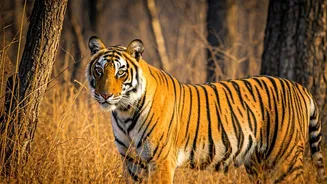Prime Tiger Habitats
India is home to numerous national parks and wildlife sanctuaries teeming with tigers, making it a prime destination for wildlife enthusiasts. Among the
most popular, Periyar National Park in Kerala offers a unique experience with its lush green landscapes and the possibility of spotting tigers in their natural environment. Bandhavgarh National Park, located in Madhya Pradesh, is renowned for its high tiger density and frequent sightings, providing incredible wildlife viewing opportunities. Other noteworthy locations include Ranthambore National Park in Rajasthan, known for its historic fort and diverse wildlife; Corbett National Park in Uttarakhand, India's oldest national park and home to a significant tiger population; and Kaziranga National Park in Assam, famous for its one-horned rhinoceroses and tiger presence. These destinations are not only havens for tigers but also offer an array of other wildlife experiences and scenic views.
Periyar Tiger Reserve
Periyar Tiger Reserve, situated in Kerala, stands out as an amazing destination during the winter months. The park is characterized by its lush greenery and the majestic Periyar Lake, providing an enchanting backdrop for tiger sightings. Travelers can enjoy boat safaris to observe tigers and various wildlife, and enhance their chances with guided treks. The reserve offers diverse experiences, making it perfect for wildlife photographers and nature lovers. Visitors also have the chance to explore the local culture and cuisine, creating a well-rounded experience. The park’s commitment to conservation, along with its unique ecosystem, makes it a must-visit location for anyone wishing to witness the beauty of tigers in the wild.
Bandhavgarh's Tiger Density
Bandhavgarh National Park in Madhya Pradesh is renowned for its remarkable tiger density, establishing it as one of the best locations for spotting these big cats. The park, famous for its unique landscape and historical significance, makes for an unforgettable wildlife experience. The high tiger population means visitors frequently spot tigers, allowing for memorable photo opportunities and increased chances of observing tiger behavior in their natural surroundings. The park also houses an array of other wildlife species, enriching the overall wildlife viewing experience, making it a top spot for animal lovers. Its exceptional tiger population, diverse ecosystem, and historical context make Bandhavgarh a highlight for wildlife tourism.
Ranthambore's Majesty
Ranthambore National Park, located in Rajasthan, provides a remarkable setting for tiger safaris, enhanced by its historic fort and diverse wildlife. This park combines the thrill of wildlife viewing with cultural and historical discovery. The ruins of Ranthambore Fort provide a breathtaking backdrop for tiger spotting, while the park's diverse ecosystem hosts various other species. The stunning scenery, coupled with the chance to see tigers in their natural environment, makes Ranthambore an excellent choice for a memorable safari experience. Furthermore, the opportunity to learn about the region’s heritage adds another layer of intrigue, allowing visitors to delve deeper into India's rich history and culture.
Corbett National Park
As India's oldest national park, Corbett National Park in Uttarakhand is home to a significant tiger population, rendering it a premier destination for wildlife lovers. Established in 1936, the park has a rich conservation history and a biodiverse environment that hosts a wealth of wildlife. Its diverse flora and fauna, plus picturesque landscapes, provide an incredible backdrop for tiger safaris, increasing the chances of observing these majestic creatures. Corbett's long-standing dedication to conservation, together with its impressive tiger numbers, makes it a top choice for wildlife tourism and a chance to experience the beauty of India’s wildlife heritage. Visitors can also enjoy the chance to experience the local culture and cuisine, ensuring a well-rounded adventure.
Kaziranga's Ecosystem
Kaziranga National Park in Assam is notable not only for its one-horned rhinoceroses but also as a habitat for tigers. This park, recognized for its unique grassland ecosystem, offers an engaging and different wildlife viewing experience. Alongside rhinos, tigers thrive, providing chances for visitors to spot them. The expansive grasslands and wetlands make it a haven for diverse wildlife and create beautiful scenery. Kaziranga's focus on conservation and its diverse wildlife make it a must-visit destination. The chance to observe tigers alongside other unique species makes it a one-of-a-kind destination for wildlife tourism.
Other Notable Parks
Apart from the main highlights, there are several other notable parks for tiger spotting in India. Tadoba Andhari Tiger Reserve in Maharashtra presents opportunities for tiger sightings, along with a diverse range of other species. Kanha National Park in Madhya Pradesh is praised for its rich biodiversity and scenic vistas. Pench National Park, also in Madhya Pradesh, offers a captivating wildlife viewing experience with lush forests. Satpura National Park, located in Madhya Pradesh, is recognized for its unique landscape and various wildlife habitats. These parks collectively present a comprehensive selection of destinations, ensuring a wide array of wildlife experiences.
Planning Your Trip
Planning a tiger safari involves considering factors such as the best time to visit, usually during the winter months when the climate is cooler and the visibility is enhanced. Booking accommodations and safaris in advance is crucial, especially during peak season. Researching the parks and choosing a reputable tour operator ensures a safe and enriching experience. Packing essentials such as comfortable clothing, binoculars, and a camera enables you to enjoy your wildlife adventure. Additionally, adhering to park regulations and respecting the wildlife and their environment is essential to conservation efforts. Taking these steps will ensure a rewarding and responsible wildlife experience.
Maximizing Tiger Sightings
To boost your chances of seeing tigers, opt for multiple safaris and venture out during the prime times, such as early morning and late afternoon when tigers are most active. Engaging the expertise of local guides and trackers, who possess extensive knowledge of tiger movements and behaviors, significantly increases your chances of spotting them. Bringing high-quality binoculars and cameras with powerful zoom lenses allows for better views and enhanced photo opportunities. Observing the tiger’s natural habitat and understanding the surroundings will further refine your wildlife viewing experience. A combination of preparation and luck can maximize your chances of witnessing the beauty of the big cat in its natural environment.
Responsible Wildlife Tourism
Responsible wildlife tourism is vital for conserving tigers and their habitats. Always abide by the rules and regulations of the national parks and follow guidelines set by tour operators. Respect the wildlife and maintain a safe distance, never disturbing their natural behaviors or disturbing their habitats. Choosing eco-friendly accommodations and supporting local communities helps minimize environmental impact and encourage sustainable tourism practices. By participating responsibly, you protect these magnificent creatures and ensure that future generations can witness the beauty of tigers in the wild, contributing to the long-term conservation of wildlife.











